 Watches and Warnings
Watches and Warnings are up for the Gulf Coast in anticipation of a Monday landfall of Hurricane Katrina.
The latest advisory shows a central pressure of 939mb and maximum sustained winds at 115 mph making her a borderline Category 3 hurricane. SHIPS intensity model is still calling for a STRONG category 4 landfall between 140 and 150mph. Models are tightening up with a hit around New Orleans proper.
This is no joke, this would be a completely devastating hurricane strike, with absolutely no precedent in the United States, not even compared to Andrew. New Orleans is anywhere from 0-30 feet below sea level (with 0 being at the Mississippi River).
Here is a quote from the
PBS show NOWWALTER MAESTRI: New Orleans is, if you think about it, it's a soup bowl. Think of a soup bowl. And the soup bowl-- the high edges of the soup bowl-- is the Mississippi River. It's amazing to say, but the highest elevation in the city of New Orleans is at the Mississippi River.
DANIEL ZWERDLING: Maestri says, imagine what happens if a hurricane like Andrew comes raging up from the Gulf:
WALTER MAESTRI: The hurricane is spinning counter-clockwise. It's been pushing in front of it water from the Gulf of Mexico for days. It's now got a wall of water in front of it some 30, 40 feet high. As it approaches the levies of the-- the-- that surround the city, it tops those levees. As the storm continues to pass over. Now Lake Ponchetrain, that water from Lake Ponchartrain is now pushed on to that - those population which has been fleeing from the western side and everybody's caught in the middle. The bowl now completely fills. And we've now got the entire community underwater some 20, 30 feet underwater. Everything is lost.
DANIEL ZWERDLING: Remember the levees which the Army built, to hold smaller floods out of the bowl? Maestri says now those levees would doom the city. Because they'd trap the water in.
WALTER MAESTRI: It's going to look like a massive shipwreck. There's going to be-- there's going to be, you know-- everything that that the water has carried in is going to be there. Alligators, moccasins, you know every kind of rodent that you could think of.
All of your sewage treatment plants are under water. And of course the material is flowing free in the community. Disease becomes a distinct possibility now. The petrochemicals that are produced all up and down the Mississippi River --much of that has floated into this bowl. I mean this has become, you know, the biggest toxic waste dump in the world now. Is the city of New Orleans because of what has happened.
If you, or anyone you know is in or around New Orleans,
I cannot strongly urge you enough to leave the city and seek higher ground. There is simply too much of a danger of extreme and prolonged flooding to stay in the city. Even a skirting hit would do serious damage to life and property and it simply is not worth it to stay.
If Jim Cantore shows up on your doorstep, it is going to get interesting.
